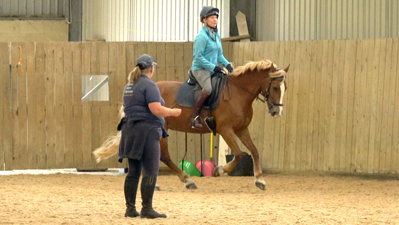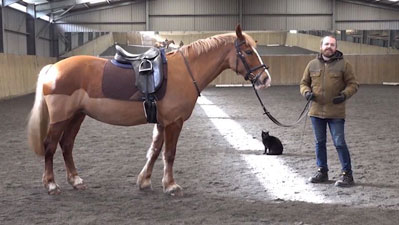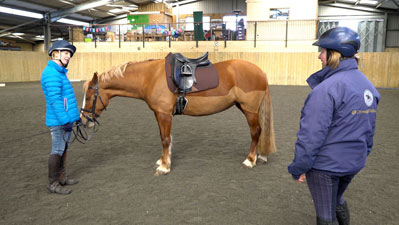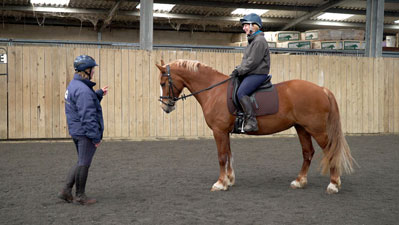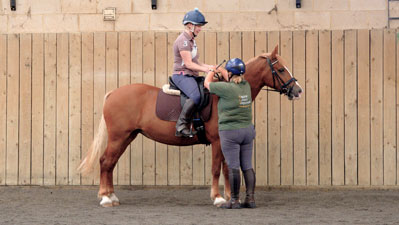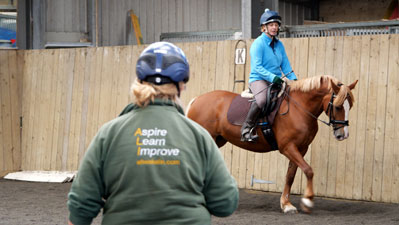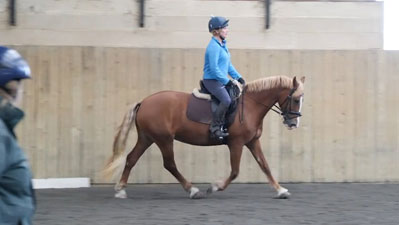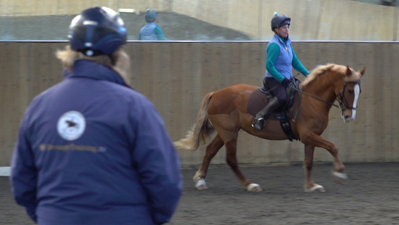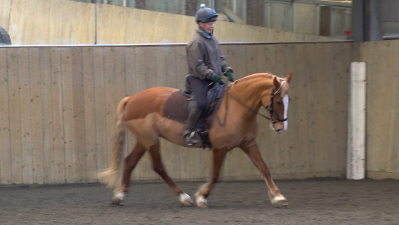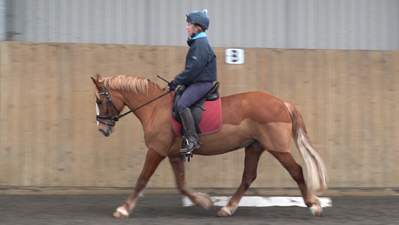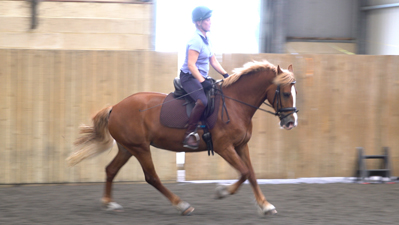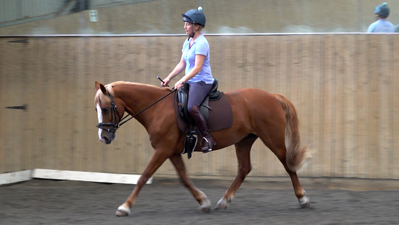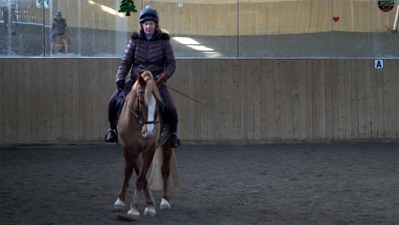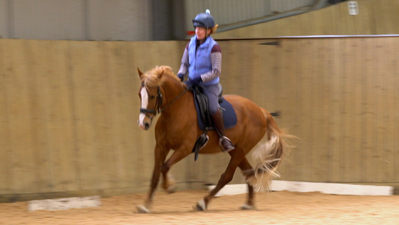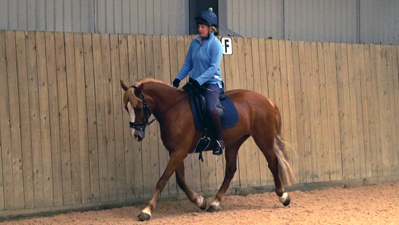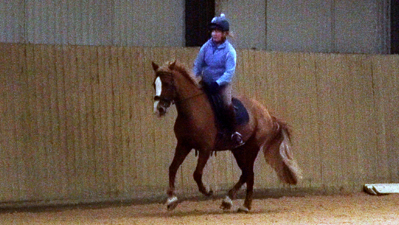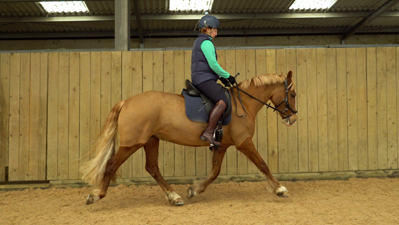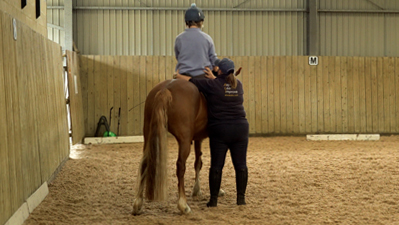
Hannah and Rosie have a packed training session with Ali covering:
- Trot-Halt Transitions
- 'Next level' leg yield
- Travers in walk
- Travers in Trot
- Canter
This session is taken from Module 1 of the Riding for Lightness course case studies. In this session, Peter assesses Rosie and finds she is a lazy/strong type of horse. Rosie is very dull and switched off to the aids. She is insensitive to the go aid, strong to the stop aid and can be quite bargey. Hannah says that Rosie was a real nightmare when she first got her, towing her around the yard going wherever she wanted to go.
Please note that we recommend wearing a hat, gloves and boots when doing groundwork with your horse.
Returning to Work After Laminitis
Session 3 (31mins): Rosie had laminitis in the Spring so has been off work for several months. In this session, Ali reassesses where they are, both on the ground and in ridden work. In groundwork, Hannah shows Ali stop, park and go. Ali reminds Hannah not to let Rosie get stuck on a level 3 of pressure. In ridden work, Ali is impressed with how straight Hannah is given how much she used to slide to the left. Ali gets Hannah to make sure her knees are bent with the weight down the front of her thighs and sitting more on her underneath. Rosie is moving nicely in trot and Hannah practices trot-walk-trot transitions. Ali gets Hannah to think about 'arm-cuffs' and pushing her hands forwards and up to make a frame with her arms for Rosie to fit into. With Hannah making a frame, Rosie does a super trot! A fantastic session with Rosie looking better than she did before having laminitis!
Session 4 (34mins): Since the last session, Hannah has been focusing on her position and keeping her hands raised. Hannah would definitely now land on her feet not on her bum if Rosie was taken out from under her! In trot, Hannah has to keep her elbows by her side, push her hands forwards and up, and remember to get to the top of the rise. Ali gets Hannah to practice some trot-walk-trot transitions. The downwards transitions are good but Rosie tries to step left rather than stay straight in the upward transitions. Rosie has to learn that 'go means go'! Hannah shows Ali canter for the first time. Hannah has to think about just changing Rosie's legs into canter not changing the speed. Hannah has to 'bounce the ball' right from the start with Rosie 'jumping' into the canter. Like most riders, Hannah has to sit slightly more back on her underneath in canter which is the opposite to walk and trot. Rosie is a great 'yeah in a minute' mare and a great distractor! Again she needs to learn 'go means go' in the canter transition and Hannah needs to target this in both walk to trot and trot to canter.
Session 5 (48mins): Ali and Hannah continue to work on keeping Hannah's hands and arms still, with less ‘wafts’, by pushing up and forward against a wall. Occasionally Rosie then comes heavy in the hand, and Hannah’s job is to remain pushing up and forward against a wall until Rosie agrees to the contact. Ali reminds Hannah to be careful what she releases for. Rosie has to find the place to be light within the frame you make, rather than you releasing to prevent an 'argument'. Rosie still wants to gravitate towards the wall which means that Hannah needs to 'be' the wall. Mary referee to the image of being hung in a harness - Hannah needs to focus on that feeling, especially in transitions. They progress to trot-halt and halt-trot where Hannah has to think ‘sit down, flat her seat bones to halt Rosie’. 'Go' is the tricky element of the transitions. Rosie needs to be more responsive to a light signal from the leg, which means that Hannah needs to be confident to use the stick to tap, rather than keep kicking - which isn’t getting a reaction. Ali reminds Hannah to go to the trot you want, not have a gradual build up. When the reactions are better, the trot is better, and the canter is better too. For Rosie and Hannah reactions to aids are tricky at the moment, Hannah must remember not to change in her body. Rosie responds well to Hannah’s corrections in her body, but she doesn’t like to give immediate reactions to aids. Revealingly, on the right rein in canter Hannah tends to go large, and on the left rein she circles. This is usually because the horse tends to drift left. Something for Hannah to be aware of and think about fixing.
Session 6 (00:37:19): Ali talks to Hannah about Rosie’s tendency towards being on the forehand, and burying her head down. Ali explains that she needs to work on making the stop lighter, which will help fix this tendency. Rosie wants to have her poll lower than her wither in a ‘pulling down heading to the ground way’. Until she learns how to bring her hind leg under her a bit, and engage her tummy—which will lift her wither—she shouldn’t be doing long and low, which in this case is falling on to the forehand, and is not long and low. Hannah comments: “You’ve transformed us Ali! In five lessons she’s a different horse.” Ali coaches Hannah through ‘Little and Big’, explaining that Hannah is riding little steps, then longer steps. ‘Little’ is the first steps towards Piaffe and Passage. Ultimate Little steps = Piaffe. Rosie needs to go ‘little’ in order to get the weight back and to be able to push more. ‘Big’ means a longer stride - which gets you the next level of trot - more towards ‘medium trot’, and therefore Novice dressage tests are possible. Ali asks Hannah how little can she make the trot, without leaning back or darting one way or another. The longer steps of ‘big’ is harder for Rosie. After the ‘little’, Rosie has to push from behind to move in to ‘big’. She gets a better trot, and Ali says that the better trot will help with the canter. They work on little, to big, to canter, which takes Rosie by surprise initially. After this exercise Hannah comments that Rosie is “lighter in front’’, because she is weighted behind. Ali explains the progression of the gaits: when ‘little’ gets easy, you go littler. The little needs to feel more powerful ‘up’, not more powerful ‘forward’. Ali thinks that a good percentage of the population are obsessed with being on the correct diagonal, but while your obsessing with the correct diagonal, the horse is able to go crooked ... ‘Being on the wrong diagonal will not cause you to die!’ In canter right Rosie wants to go out through the shoulder and that can get you the wrong lead. Canter Right is slightly behind canter left because of straightness on that rein, but Hannah is delighted with the trot-canter transitions on the left rein that are achieved after the ‘Little-Big’ exercise.
Session 7 (22:57 mins): This session has a recorded voiceover due to a sound recording issue on the day.
Hannah has a really good basic line up, but has a tendency to draw her right leg back when she nudges - Ali explains that this is possibly because Rosie has more ‘whoa’ than ‘go’ and Hannah has to work hard to keep Rosie thinking forward. She has been working on riding with shorter reins, getting her elbow back, and thinking of pushing up against a resistance to stop her hands dropping down, but finds it hard when there are lots of other things to think about.
Once Rosie’s rhythm becomes established, the reach in to the rein becomes more consistent. It is easy to focus on correcting the head rather than rhythm and straightness. but correcting both of these allow consistent contact.
When the first leg goes in to walk a slight release on the rein gives the horse the praise it needs to know it’s what is being asked of it. After a few trot/walk transitions Rosie has a super trot with lovely reach in the rein.
When they work on 'Little and Big Trot' Rosie shortens her stride beautifully, but she also needs to keep ‘quick legs’. Once the horse learns to shorten it’s stride, if you can keep the quick legs, you’ll then keep the reach in the rein, because the core is engaged and it’s back up.
In this session Hannah starts to ask Rosie to go 'bigger' so that she slightly lengthens her stride for a better working trot - what Ali calls more of a Novice working trot.
As Rosie goes bigger, she’d like to go bigger in a ‘pull her neck down' sort of way and tip Hannah slightly forward. Hannah needs to 'plug in' on the sit phase, in the same place every time, and keep her hands up to help prevent this. This exercise results in a much improved working trot.
Transitions to canter often involve Rosie running in to canter, when Hannah asks for canter, she gets step left, speed up, rather than change in to canter. It really helps to work through the straightness issues in walk and trot, often the straightness can be kept because we are aware of the potential issues.
Rosie finds the canter hard work when Hannah is plugged in and asks Rosie to strike off more from the hind leg. What Rosie would like to do in the transitions is put her nose to the right and dive out to the left which is the same biomechanical pattern that we see in the trot, where Hannah needs to correct herself by feeling like she is looking at the wall rather than round the circle. this way she can steer from the outside and things will start to change in terms of straightness.
When Rosie’s head comes up she is running out to the left. With each canter transition there is less going left, and less hollowing. Rosie and Hannah are much straighter on the left rein in canter.
Session 8 (00:39:30): Hannah has been working on staying stacked up in front of Hannah. Looking through Rosie’s ears has been a massive deal for Hannah on the right rein. When you look through the horses ears and look at where you want the horse to go in two steps time, not in ten steps time will keep you straight, and keep her straight.
Hannah and Rosie had an attempt at moving yards, which Rosie didn’t enjoy, so they are back at their old yard. The moves have meant that they haven’t done as much riding between the sessions, but this hasn’t effected their progress.
Sometimes riding an easy test and using it to work on your position, and not worry about the score can be a really good thing.
In trot on the left rein Rosie likes to look left and falls out through the shoulder. Ali reminds Hannah that thinking of ‘energy’ and quickness of legs in ‘little’ trot is important, and that she needs to bend her elbows and have her hands higher than she thinks. Then think as if you could piaffe for 'Little' trot, which Rosie does easily. Rosie then ignores Hannah’s ‘Go’ signal after going ‘Little’. Ali says that Rosie is born to collect and piaffe - she finds it easy - but finds ‘Big’ less easy. Hannah says she’s been breaking in to canter sometimes, when asked for ‘Big’ trot. Rosie wants to do anything other than go big, what she wants to do is go out through the right shoulder.
Hannah is thinking of the ‘gym-ball’ of Rosie’s rib-cage being underneath her. Focusing on the gym-ball being straight underneath her will help the transitions within the paces, and the energy and extension in the trot.
In the canter transitions Hannah still needs to think of the gym-ball, remembering 'chin over mane' and lifting her hands. Ali says she needs to go slightly quicker and accelerate in to the canter. Rosie likes to stick her nose in the air in the transition to canter. Rosie’s response to Hannah putting her leg on is to slow her legs and hollow, but the response should be ‘jump in to canter’.
Looking is magic! Looking through the ears has made a huge impact on the canter. Ali suggests imagining a line on the ground and to look through the ears along that line, then you notice where the line wiggles.
Steering from the outside is a big part of straightness too. Imagine the inside rein has snapped, you should be able to steer from the outside thigh. Hannah has to think of bouncing the ball, especially on the left rein where Rosie wants to ‘run off with a rugby ball’, on the left have to feel like she’s about to fall in to trot, but not trot.
Session 9 (39:43 mins): Hannah and Rosie competed the day before filming and won their class (See the test sheet below)! Congratulations Hannah and Rosie! Since the last filming session Hannah has been working on canter transitions, little and big, and trying to keep her lower leg a bit stiller, and trying to keep her hands still so Rosie doesn’t swing her nose. Ali discusses the cause of the wiggling lower leg, and how to fix it.
They look at flex and step to encourage Rosie to be straight rather than put her nose left and shoulder and ribcage right. This is the key to fixing Hannah’s wobbly right hand.
Rosie’s answer to ‘go’ is step sideways in transitions, and is most evident trot-canter, but it needs to be ‘go’.
In trot Hannah must think 'ping' instead of 'soggy sofa' in the rise to try to get her legs moving quicker.
Rosie needs to be thinking forward.
They achieve some great straight trot, and then a straight first transition to canter, but Rosie slows down in to the transition. Hannah can use the idea of flex right, step left in the canter to keep her straight and get a bit more ‘go’. They focus on getting Rosie’s weight on to her outside hind leg in canter, but Rosie would like to have most of her weight on her forelegs, and tipping Hannah forward, so Hannah needs to think of sitting on to the back left of her seat because that’s what will connect to the left hind leg (when on the right rein).
On the left rein Rosie finds canter much easier, and is straighter and more willing to commit to the right (outside) hind being the one that begins the word CANada. On the right rein she likes to be more CanaDA with the front legs hitting the ground to make the DA of Canada,
Session 10: Hannah & Rosie return and begin with Ali by looking at how they can walk without 'the balloon deflating'. Rosie sees walk as ‘relax’, which isn’t ideal in a dressage test. Rosie likes to live ‘head down, bum up’, and before lockdown Ali and Hannah worked towards fixing this, and it's evident that Hannah has been working on the fixes, which is demonstrated by the first trot transition.
They then look at how Hannah lengthens her front, which goes with Rosie lengthening her underneath, they look at fixing this, as well as recapping little and big, and straightness on a circle in walk trot and canter.
It’s clear Hannah has been working hard over lockdown and the canter transitions are much improved.
Session 11 (37:30 mins): Hannah and Rosie have been out competing since last time, and had mixed results.
Hannah says she has been working on canter transitions and has been thinking of keeping her hands ‘self-contained’. The more the horse doesn’t want to go, the more we end up shoving and kicking and the more we end up down the hole, the more the horse can’t use their hind legs.
Hannah’s left leg likes to come forward, which suggests that Hannah is sliding off right on the left rein too. Ali reminds Hannah that she can take a quick glance at her knees to check that her legs are a pair. Hannah can also think about steering from the outside.
They look at trot to begin with, then move to some ridden groundwork. They start with hind legs stepping under, which Rosie wants to step forward with, then front legs, quickly moving on to side pass, which Ali says will be tricky because the responses for the individual legs aren’t quite trained as yet. Rosie gets in a bit of a muddle, but they break it down and they achieve some clear steps. Going right is easier than going left for Rosie.
When the take trot once more, after working on side pass, Ali says "On the right rein, when you feel she’s falling in to the right, you can think as if you’re doing side pass left" to help with straightness.
They take another look at canter, where Hannah has a tendency to slide off left, and Ali says that the first fix is to get Hannah straight. There will then be a straightness correction for Rosie too. Canter left involves Hannah feeling like she’s looking left, and side passing round the corners, this creates straightness, and Hannah comments that there is a feeling of Rosie coming up through her shoulders.
Session 12 (33:39)Rosie has had a little time off, and has come back in great shape. They begin with some trot-walk-trot transitions, working on some corrections in the downwards transitions where Hannah’s left leg likes to come forward. When Hannah corrects this, the transitions are much improved. They get some ‘super trot’ with great straightness, which in turn enables Rosie to push off in to trot from her quarters.
They move on to look at hind legs over, and front legs over, working on the moment of release. Moving sideways doesn’t come easily to Rosie, but considering she’s had time off, she makes a good effort. They move on to leg yield in walk, and Ali helps Hannah find some fixes for her position that help Rosie keep straight - it’s mostly Hannah thinking about her body ‘being left’ that helps.
The leg yield in trot on the right rein needs focus on keeping Rosie at just the right speed, and Hannah keeping herself left that gets some beginnings of good leg yield, the trot afterward is improved hugely. On the left rein Hannah finds that she has to really focus on looking to where she wants to go, instead of down the inside foreleg to the floor. Hannah finds it really hard to keep herself to the right, which actually gets her ‘in the middle’.
The trot after the leg yield is great, and the first canter transition after the leg yield is fantastic, and the canters are much improved.
Session 13 (31:34 mins): Hannah and Rosie have had a bit of a break from competing, but went out at the weekend and came first in their class!
They recap Hannah’s position, focusing on hand position and lower leg, then recap leg yield in walk, and trot which leads to a hugely improved canter transition.
It’s a great first session back after quite a break, with Rosie and Hannah much straighter.
Session 14 (42:05) In this session Hannah and Rosie work on a few of the elements they will be riding in an upcoming Novice test. Hannah would like to improve medium trot, so they begin with some little and big, and talk about thinking little just before the medium trot element to assist Rosie in the transition to medium trot. Once they've worked on the trot on the long side, they test it across the diagonal.
They then revisit leg yield and work on some rider straightness issues that Rosie would like to join in with.
They then move on to canter, and now that they have really nailed the canter transitions, look at how the canter can be slowed to encourage it to be more 'up'.
A great session which really emphasises just how far Hannah & Rosie have come in their training, and how every improvement leads to the next challenge.
Session 15 (25:37 mins): Hannah and Rosie hav
e missed a couple of sessions with Ali, but come back looking great.
This session looks at leg yield, which Hannah thinks isn't going very well, but immediately produces a very straight version in walk! They then look at leg yield in trot and move on to canter, and discuss how the canter now is working towards Novice level. The transitions are much improved, although Rosie finds canter right harder so they spend some time improving those transitions and Rosie's responsiveness.
Hannah and Rosie have a packed training session with Ali covering:
- Trot-walk-trot
- Straightness for better transitions
- Leg yield in trot
- 'Tractor Bucket' for improved canter & canter transitions
- Medium trot
-
This session includes:
- Slow & Fast Trot rather than Little & Big - working towards passage
- Travers in walk and trot
- The term 'tractor bucket' & how it's helpful when thinking of 'lifting' the shoulders
- "Miracles do happen" with improvements in canter
- Canter
- Knowing when you're ready to step up to Novice
Hannah and Rosie have a packed training session with Ali covering:
- Trot-Halt Transitions
- 'Next level' leg yield
- Travers in walk
- Travers in Trot
- Canter

